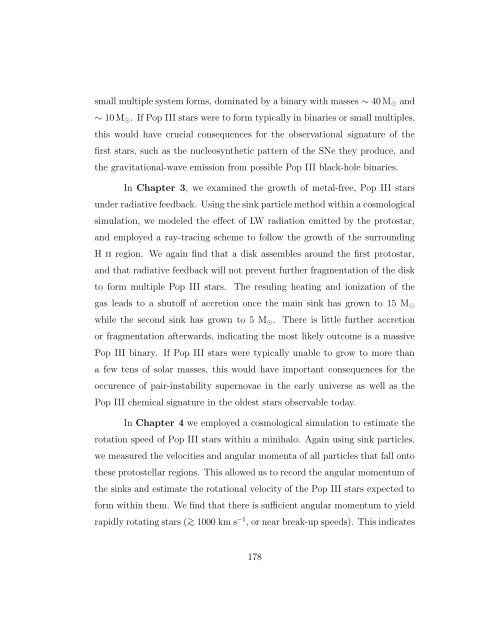Copyright by Athena Ranice Stacy 2011 - The University of Texas at ...
Copyright by Athena Ranice Stacy 2011 - The University of Texas at ...
Copyright by Athena Ranice Stacy 2011 - The University of Texas at ...
You also want an ePaper? Increase the reach of your titles
YUMPU automatically turns print PDFs into web optimized ePapers that Google loves.
small multiple system forms, domin<strong>at</strong>ed <strong>by</strong> a binary with masses ∼ 40 M⊙ and<br />
∼ 10 M⊙. If Pop III stars were to form typically in binaries or small multiples,<br />
this would have crucial consequences for the observ<strong>at</strong>ional sign<strong>at</strong>ure <strong>of</strong> the<br />
first stars, such as the nucleosynthetic p<strong>at</strong>tern <strong>of</strong> the SNe they produce, and<br />
the gravit<strong>at</strong>ional-wave emission from possible Pop III black-hole binaries.<br />
In Chapter 3, we examined the growth <strong>of</strong> metal-free, Pop III stars<br />
under radi<strong>at</strong>ive feedback. Using the sink particle method within a cosmological<br />
simul<strong>at</strong>ion, we modeled the effect <strong>of</strong> LW radi<strong>at</strong>ion emitted <strong>by</strong> the protostar,<br />
and employed a ray-tracing scheme to follow the growth <strong>of</strong> the surrounding<br />
H ii region. We again find th<strong>at</strong> a disk assembles around the first protostar,<br />
and th<strong>at</strong> radi<strong>at</strong>ive feedback will not prevent further fragment<strong>at</strong>ion <strong>of</strong> the disk<br />
to form multiple Pop III stars. <strong>The</strong> resuling he<strong>at</strong>ing and ioniz<strong>at</strong>ion <strong>of</strong> the<br />
gas leads to a shut<strong>of</strong>f <strong>of</strong> accretion once the main sink has grown to 15 M⊙<br />
while the second sink has grown to 5 M⊙. <strong>The</strong>re is little further accretion<br />
or fragment<strong>at</strong>ion afterwards, indic<strong>at</strong>ing the most likely outcome is a massive<br />
Pop III binary. If Pop III stars were typically unable to grow to more than<br />
a few tens <strong>of</strong> solar masses, this would have important consequences for the<br />
occurence <strong>of</strong> pair-instability supernovae in the early universe as well as the<br />
Pop III chemical sign<strong>at</strong>ure in the oldest stars observable today.<br />
In Chapter 4 we employed a cosmological simul<strong>at</strong>ion to estim<strong>at</strong>e the<br />
rot<strong>at</strong>ion speed <strong>of</strong> Pop III stars within a minihalo. Again using sink particles,<br />
we measured the velocities and angular momenta <strong>of</strong> all particles th<strong>at</strong> fall onto<br />
these protostellar regions. This allowed us to record the angular momentum <strong>of</strong><br />
the sinks and estim<strong>at</strong>e the rot<strong>at</strong>ional velocity <strong>of</strong> the Pop III stars expected to<br />
form within them. We find th<strong>at</strong> there is sufficient angular momentum to yield<br />
rapidly rot<strong>at</strong>ing stars (> ∼ 1000 km s −1 , or near break-up speeds). This indic<strong>at</strong>es<br />
178









